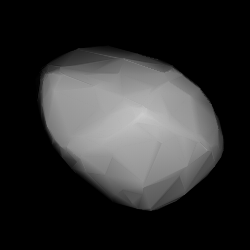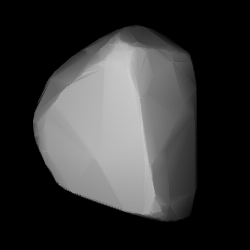
199 Byblis is a medium-sized main belt asteroid.

343 Ostara is a background asteroid from the inner region of the asteroid belt. It was discovered by German astronomer Max Wolf at the Heidelberg Observatory on 15 November 1892.
Seppina is a minor planet orbiting the Sun.
Mabella is a minor planet orbiting the Sun.

Sara is a minor planet orbiting the Sun.

Nassovia is a minor planet orbiting the Sun. It is a member of the Koronis family of asteroids.
Bandusia is a minor planet orbiting the Sun.
609 Fulvia is a minor planet orbiting the Sun.
615 Roswitha is a minor planet orbiting the Sun.

621 Werdandi is a Themistian asteroid.
625 Xenia is a minor planet orbiting the Sun. It was discovered by August Kopff in Heidelberg, Germany, on 11 February 1907. The name may have been inspired by the asteroid's provisional designation 1907 XN.

629 Bernardina is a minor planet orbiting the Sun.
634 Ute is a minor planet orbiting the Sun.

644 Cosima is a minor planet orbiting the Sun.
726 Joëlla is a minor planet orbiting the Sun. It was discovered on November 22, 1911, by Joel Hastings Metcalf, in Winchester, Massachusetts, in the United States.
818 Kapteynia is a minor planet orbiting the Sun. This asteroid is named for the Dutch astronomer Jacobus Kapteyn.

819 Barnardiana is a minor planet orbiting the Sun, discovered on March 3, 1916, by the German astronomer Max Wolf in Heidelberg.
872 Holda is a minor planet orbiting the Sun.
(589683) 2010 RF43 (provisional designation 2010 RF43) is a large trans-Neptunian object orbiting in the scattered disc in the outermost regions of the Solar System. The object was discovered on 9 September 2010, by American astronomers David Rabinowitz, Megan Schwamb and Suzanne Tourtellotte at ESO's La Silla Observatory in northern Chile.
2021 LL37 is a large trans-Neptunian object in the scattered disc, around 600 kilometres (370 miles) in diameter. It was discovered on 12 June 2021, by American astronomers Scott Sheppard and Chad Trujillo using Cerro Tololo Inter-American Observatory's Dark Energy Camera in Chile, and announced on 31 May 2022. It was 73.9 astronomical units from the Sun when it was discovered, making it one of the most distant known Solar System objects from the Sun as of May 2022. It has been identified in precovery images from as far back as 28 April 2014.








